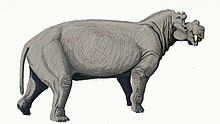Dinocerata (from the Greek δεινός (deinós), "terrible", and κέρας (kéras), "horn") or Uintatheria,[1] also known as uintatheres, is an extinct order of large herbivorous hoofed mammals with horns and protuberant canine teeth, known from the Paleocene and Eocene of Asia and North America. With body masses ranging up to 4,500 kilograms (9,900 lb) they represent some of the earliest known large mammals.[2]
| Dinocerata Temporal range: | |
|---|---|
 | |
| Skeleton of Uintatherium | |
 | |
| Life restoration of Uintatherium. | |
| Scientific classification | |
| Domain: | Eukaryota |
| Kingdom: | Animalia |
| Phylum: | Chordata |
| Class: | Mammalia |
| Clade: | †Uintatheriamorpha |
| Order: | †Dinocerata Marsh, 1872 |
| Families and genera | |
|
See text | |
Description

Over the course of their evolution, dinoceratans underwent a great increase in body size, from a weight of 175 kilograms (386 lb) in the earliest species to a weight of up to 4,500 kilograms (9,900 lb) in the largest species, co-inciding with the development of fully graviportal limbs with a digitigrade posture. Later members of the order are noted for their distinctive pairs of horns that develop from the maxillary and parietal bones of the skull, along with the development of elongated upper canines. The upper incisors were also lost, and the bilophodont nature of the molar teeth was enhanced.[2]
Ecology
Evolution
The oldest and most primitive members of the group, such as Prodinoceras, appeared virtually simultaneously during the late Paleocene in North America and Asia, indicating connection between the two landmasses, with uintatheres continuing to exchange between the landmasses during the Eocene, as suggested by the presence of Uintatherium in both North America and China. Uintatheres became extinct towards the end of the Middle Eocene, for unknown reasons.[2]
Classification
The affinities of the group within Placentalia have historically been contentious. A 2015 phylogenetic study recovered Dinocerata as part of Laurasiatheria, closely related to ungulates and "condylarths", with Dinocerata placed as the sister group to the South American native ungulate group Xenungulata.[3] A close relationship with Xenungulata was first proposed in 1985, with the proposed clade containing both groups named Uintatheriamorpha,[2] though other authors have suggested that these similarities are likely to be due to convergence.[4]
Taxonomy and phylogeny
Dinocerata is generally divided into two families, "Prodinoceratidae", containing the most primitive genus Prodinoceras,[2] with some authors also choosing to include the genus Probathyopsis[5], and Uintatheriidae, containing all other genera. Members of Prodinoceratidae are likely ancestral to Uintatheriidae.[2] The Asian uintatheriid genus Gobiatherium is often placed into its own separate subfamily Gobiatheriinae, with all other uintatheriids belonging to the subfamily Uintatheriinae.[6]
- Order Dinocerata
- Family Prodinoceratidae
- Family Uintatheriidae
References
Wikiwand in your browser!
Seamless Wikipedia browsing. On steroids.
Every time you click a link to Wikipedia, Wiktionary or Wikiquote in your browser's search results, it will show the modern Wikiwand interface.
Wikiwand extension is a five stars, simple, with minimum permission required to keep your browsing private, safe and transparent.
